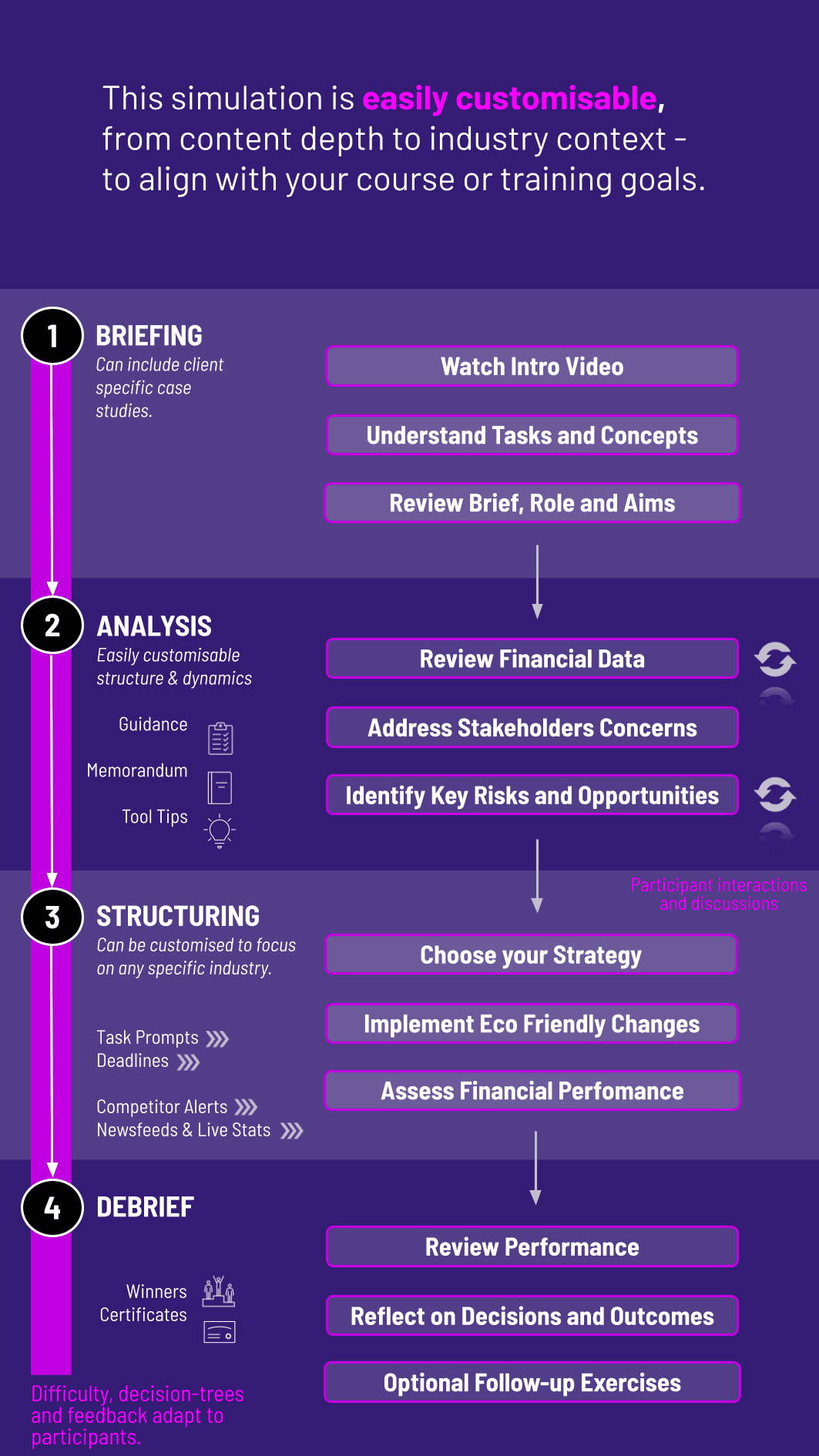
In this hands-on Climate Risk Simulation, participants act as corporate or financial leaders navigating environmental, regulatory, and market risks. They balance sustainability, profitability, and reputation while making high-stakes strategic decisions.
Climate-related financial disclosures and reporting
Transition risk: carbon pricing, regulation, and investor pressure
Physical risk: climate shocks, supply chain disruption, and resilience
ESG integration and stakeholder alignment
Green finance, carbon markets, and sustainable investment
Trade-offs between profit and environmental responsibility
Communication and reputation management
Scenario planning and stress testing
Innovation and sustainable product strategy
Ethics, governance, and accountability in climate-related decisions


Assess financial and operational exposure to climate risks
Decide on mitigation strategies like divestment, carbon offsets, or green innovation
Balance stakeholder pressure from regulators, investors, NGOs, and communities
Manage crises such as natural disasters or public protests
Communicate strategy in board presentations, press releases, or investor calls
Adapt decisions across multiple rounds as climate risks evolve
By the end of the simulation, participants will be able to:
Identify and assess physical and transition climate risks
Integrate ESG considerations into strategic decision-making
Balance short-term profitability with long-term sustainability
Evaluate financial trade-offs in mitigation and adaptation strategies
Communicate effectively with diverse stakeholders under pressure
Understand climate-related reporting frameworks and investor expectations
Strengthen resilience planning across business models and industries
Make ethical decisions in the face of competing pressures
Apply scenario planning to uncertain and complex environments
Collaborate across functions to build sustainable strategies
The simulation’s flexible structure ensures that these objectives can be calibrated to match the depth, duration, and focus areas of each program, whether in higher education or corporate learning.
This simulation can be delivered in classrooms, workshops, or corporate programs, and run individually or in teams. Each cycle builds complexity and mirrors real-world climate risk dynamics.
1. Receive a Scenario or Brief: Each round begins with a scenario - such as new regulation, climate-related losses, or shifting investor sentiment. Participants are given objectives and context.
2. Analyse the Situation: They review financial data, stakeholder expectations, and environmental metrics, identifying key risks and opportunities.
3. Make Strategic Decisions: Participants choose between mitigation and adaptation strategies, resource allocations, and communication tactics - all with financial and reputational consequences.
4. Collaborate and Role-Play: In team formats, participants role-play as executives, regulators, or investors, negotiating and aligning strategies.
5. Review Results and Reflect: Feedback highlights financial performance, ESG credibility, and stakeholder reactions. Participants reflect on successes and missteps.
6. Repeat and Iterate: Each new round introduces additional complexity, requiring participants to adapt and refine strategies.
Do participants need climate finance expertise? No. The simulation provides all necessary context, making it accessible for all levels.
Can the simulation be customized for specific industries? Yes. It can reflect energy, manufacturing, banking, or consumer industries depending on the audience.
Is this simulation suitable for executive training? Absolutely. It’s ideal for boards, senior managers, and policy professionals.
Does it cover both physical and transition risks? Yes. Participants encounter climate shocks as well as policy and regulatory challenges.
How long does the simulation take? It can run as a short 2-hour exercise or be extended into multi-day programs.
Is there a role-play component? Yes. Teams can represent different stakeholders - executives, regulators, NGOs, or investors.
Does the simulation include ESG frameworks? Yes. Concepts like TCFD, ESG ratings, and carbon disclosure can be embedded.
How is performance measured? Through financial outcomes, ESG credibility, stakeholder trust, and adaptability.
Can it run online as well as in person? Yes. It’s fully digital and suitable for remote or hybrid delivery.
Is it applicable to universities? Yes. It integrates well into MBA, economics, sustainability, and policy courses.
Climate risk identification and management
Strategic alignment of adaptation and mitigation choices
Communication quality in stakeholder contexts
Responsiveness to changing external conditions
Collaboration and negotiation effectiveness
You can also include memo writing and debrief presentations as part of the assessment structure. Additionally, you can also add a built-in peer and self-assessment tool to see how participants rate themselves. This flexibility allows the simulation to be easily integrated by professors as graded courses at universities and by HR at assessment centres at companies.
Join this 20-minute webinar, followed by a Q&A session, to immerse yourself in the simulation.
or
Book a 15-minute Zoom demo with one of our experts to explore how the simulation can benefit you.